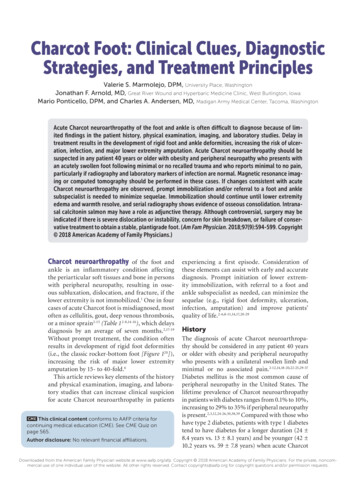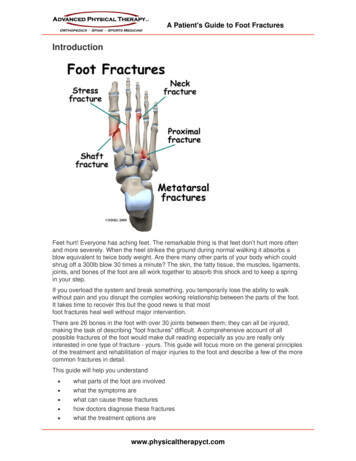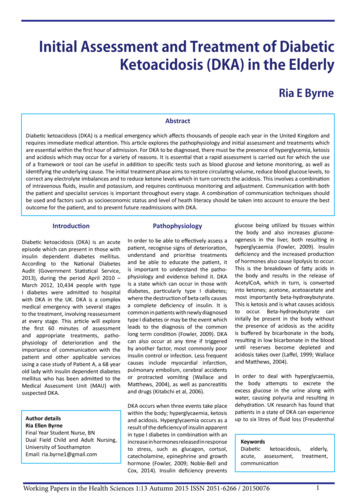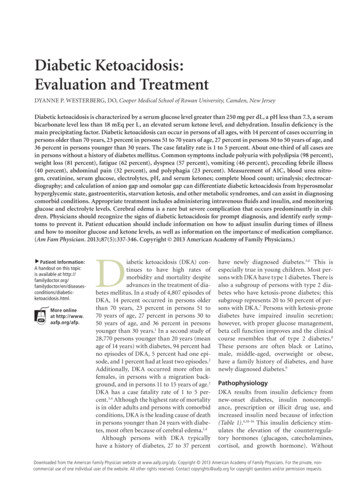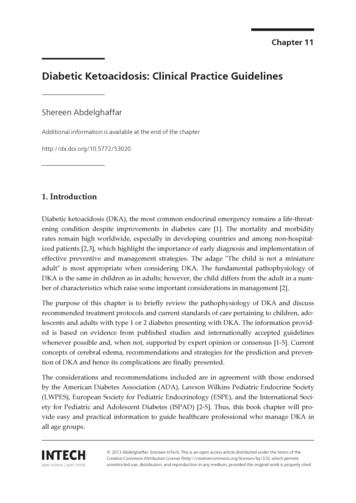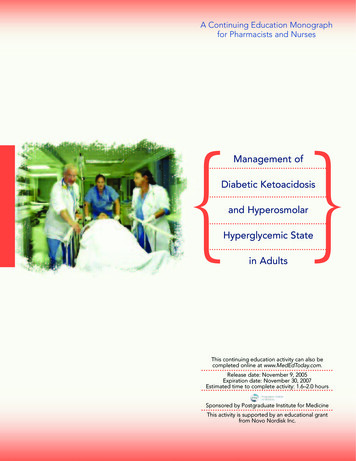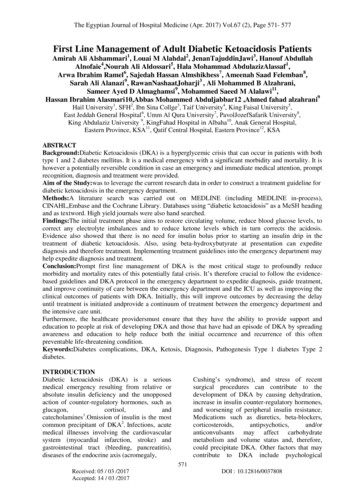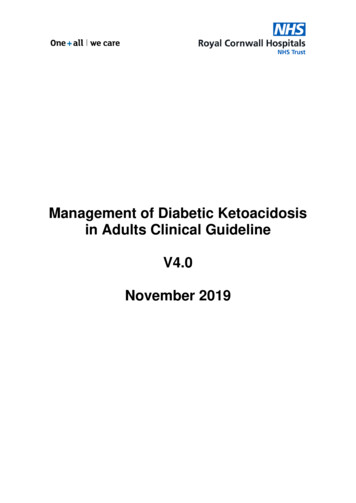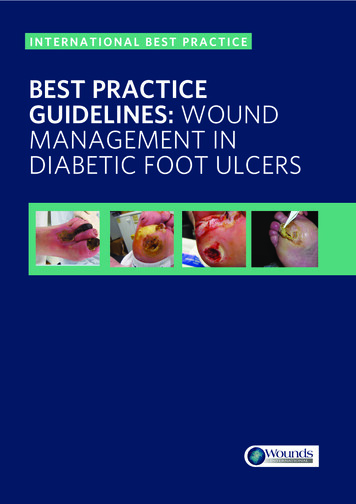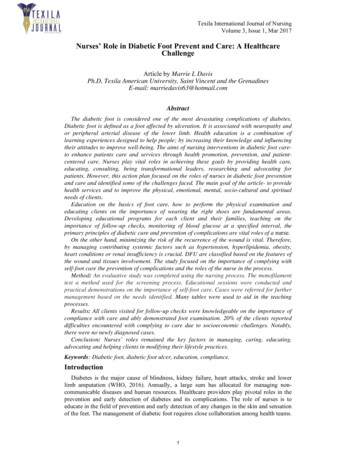
Transcription
Texila International Journal of NursingVolume 3, Issue 1, Mar 2017Nurses’ Role in Diabetic Foot Prevent and Care: A HealthcareChallengeArticle by Marrie L DavisPh.D, Texila American University, Saint Vincent and the GrenadinesE-mail: marriedavis63@hotmail.comAbstractThe diabetic foot is considered one of the most devastating complications of diabetes.Diabetic foot is defined as a foot affected by ulceration. It is associated with neuropathy andor peripheral arterial disease of the lower limb. Health education is a combination oflearning experiences designed to help people; by increasing their knowledge and influencingtheir attitudes to improve well-being. The aims of nursing interventions in diabetic foot careto enhance patients care and services through health promotion, prevention, and patientcentered care. Nurses play vital roles in achieving these goals by providing health care,educating, consulting, being transformational leaders, researching and advocating forpatients. However, this action plan focused on the roles of nurses in diabetic foot preventionand care and identified some of the challenges faced. The main goal of the article- to providehealth services and to improve the physical, emotional, mental, socio-cultural and spiritualneeds of clients.Education on the basics of foot care, how to perform the physical examination andeducating clients on the importance of wearing the right shoes are fundamental areas.Developing educational programs for each client and their families, teaching on theimportance of follow-up checks, monitoring of blood glucose at a specified interval, theprimary principles of diabetic care and prevention of complications are vital roles of a nurse.On the other hand, minimizing the risk of the recurrence of the wound is vital. Therefore,by managing contributing systemic factors such as hypertension, hyperlipidemia, obesity,heart conditions or renal insufficiency is crucial. DFU are classified based on the features ofthe wound and tissues involvement. The study focused on the importance of complying withself-foot care the prevention of complications and the roles of the nurse in the process.Method: An evaluative study was completed using the nursing process. The monofilamenttest a method used for the screening process. Educational sessions were conducted andpractical demonstrations on the importance of self-foot care. Cases were referred for furthermanagement based on the needs identified. Many tables were used to aid in the teachingprocesses.Results: All clients visited for follow-up checks were knowledgeable on the importance ofcompliance with care and ably demonstrated foot examination. 20% of the clients reporteddifficulties encountered with complying to care due to socioeconomic challenges. Notably,there were no newly diagnosed cases.Conclusion: Nurses’ roles remained the key factors in managing, caring, educating,advocating and helping clients in modifying their lifestyle practices.Keywords: Diabetic foot, diabetic foot ulcer, education, compliance.IntroductionDiabetes is the major cause of blindness, kidney failure, heart attacks, stroke and lowerlimb amputation (WHO, 2016). Annually, a large sum has allocated for managing noncommunicable diseases and human resources. Healthcare providers play pivotal roles in theprevention and early detection of diabetes and its complications. The role of nurses is toeducate in the field of prevention and early detection of any changes in the skin and sensationof the feet. The management of diabetic foot requires close collaboration among health teams.1
Texila International Journal of NursingVolume 3, Issue 1, Mar 2017Compliance to treatment can lead to the increased longevity of clients. The prevention ofcomplications such as eyes, renal, cardiovascular, diabetic foot and impose cost and economicburden on health systems (2006).The diabetic foot is considered one of the most devastating complications of diabetes.Diabetic foot is defined as a foot affected by ulceration. It is associated with neuropathy andor peripheral arterial disease of the lower limb (Lauterbach, 2010). It is important to note that,care and treatment of diabetic foot are costly worldwide. Therefore, compliance with self andfoot care are essential aspects of care. Compliance is the extent to which clients correctlyfollows medical advice such as medication, dietary plan, and self-care. It also applies to othersituations such as medical devices used, self-care, self-directed exercises or therapy sessions(WHO, 2003). Diabetic foot ulcers are results of peripheral nerves damages and arterialdiseases (Naves, 2016).Health education is a combination of learning experiences designed to help people; byincreasing their knowledge and influencing their attitudes to improve well-being (WHO,2017). The aims of nursing interventions in diabetic foot care are to enhance patients care andservices through health promotion, prevention, and patient-centered care. Nurses play vitalroles in achieving these goals by providing health care, educating, consulting,transformational leadership, researching and advocating for patients. However, this actionplan focuses on the roles of nurses in diabetic foot prevention and care. The main goal of thearticle is to provide health services and to improve the physical, emotional, mental, sociocultural and spiritual needs of the clients. The care provided must be evident–based andrender through a holistic approach.However in St. Vincent and the Grenadines diabetic foot ulcerations (DFU) contributed formost of the amputations done at the main health facility, the Milton Cato Memorial Hospital(MCMH). In 2000, 60.4% of DFU resulted in amputations, in 2001 and 2002 respectively atotal of 65% increased. Moreover, the average length of hospitalization for a diabetic patientwith an amputation average about 52 days and the cost of treatment among to 3 000 00Easter Caribbean dollars. Hence, the importance of nurses’ roles to prevent and to improvethe quality of care rendered. Also, to combat the many healthcare challenges encountered.Weekly educational sessions and demonstrations were conducted at the Poly Clinic; one ofthe strategies used to educate diabetic clients on the prevention of complications, compliancewith care. Many methods were implemented whereby clients could have a betterunderstanding and acknowledged the importance of complying with care and the possibleoutcomes. An evaluation of the daily sessions and examination of clients complied. Actualand potential needs were identified and the relevant cases referred for further interventions.Specific goalTo enhance patients care and services through: health promotion, prevention, and patientcentered care on managing foot-care.MethodologyAn evaluative study was completed using the nursing process, assessments of the feet andthe monofilament test were methods implemented for examination and screening. Weeklyfoot examinations were done to assess for foot temperature, toes and soles pressure, anddetection for sores, cuts, lacerations, callus and observation for discoloration and skinchanges. The monofilament test was applied to determine loss of protective sensation of thefeet.Complete physical assessment on all diabetic clients visited the Poly Clinic for follow-upchecks were completed for the period of one month. A brief explanation of the examinationprocess and screening were explained to each diabetic client. Oral consent was obtained. Fivediabetic clients were examined and screened daily. Educational sessions were conducted. Thesignificance of complying with self-care was discussed. Practical demonstrations were doneto help clients to understand the importance of self-foot care. Cases were referred for further2
Texila International Journal of NursingVolume 3, Issue 1, Mar 2017management based on findings and actual and potential needs identified. Many approacheswere used to aid in the teaching processAction plan: the roles of the nurseExamination and screening-A neurological examination is the first criterion for screeningand detection of foot ulcers. Nurses’ role in diabetic foot care involves foot examination,wound care and encourage patients and their families on the necessary care and follow-upvisits. Screening is a critical part of care. It allows for early detection of diabetic footproblems, identification of those at risk and planning of care to reduce the risk of ulcers.A foot examination is a routine assessment of temperature, vascular, toe, and sole pressure.A foot care examination includes checks for circulation, nerve damage, skin change, anddeformities. Good communication with the client during the process helps to identify otherunderlying problems.Devices including a monofilament or tuning fork aided in determining the extent of nervedamage. A monofilament is a thin, flexible thread used. The sense of pressure in various areasof the foot is determined. The tuning folk assessed the sense of vibration in various parts suchas the foot and toe joints.The monofilament testing is done to determine loss of protective sensation of diabeticneuropathic feet for adults and children. It is an inexpensive assessment identifying clients atrisk for developing a foot ulcer. Early detection reduces the incidence of diabetic neuropathiculcers. The Semmes-Weinstein 5.07 monofilament takes 10 grams of force to bend it when ittouches on the skin or foot. An inability to detect the degree of force indicates that the clienthas loss of protective sensation in the foot. A monofilament test should be done yearly as partof an overall assessment for persons diagnosed with diabetes, diabetic foot ulcer, numbness,and tingling, burning or crawling sensation in one or both feet. Diabetic care is holistic andensuring effective care all other areas of care is vital. Table one indicated the other areas ofcare necessary for managing diabetic foot ulcer.Holistic approach to ensure effective care of foot ulcersTable 1The past, present and familyhistory, medications andallergiesCheck for other complications Glycemic controlCheck for medications that may inhibithealing such as steroids andimmunosuppressantNeurological, vision, cardiac, renal, vascularHb (Hemoglobin) A1c 7.5% (depending onthe specific situation of the patient, e.g.medication, risk of hypoglycemia, bodyweight) Hypertension control 140/90 mmHg Hyperlipidemia controlCholesterol 5.2 mmol/L (200 mg/dL)Blood sugar control-The primary cause of DFU is due to inadequate control of the bloodglucose level (Bowering, 2001). The best indicator of glucose control is HbA1c. It measuresthe average blood sugar concentration over a 90-d span of the average red blood cell in theperipheral circulation. A high HbA1c level indicated glycosylation of hemoglobin. Greaterelevation of blood glucose level has been associated with a higher potential for suppressinginflammatory responses and decreasing host response to infection. Therefore, controlling theblood glucose is vital to prevent foot ulcers.Nurses’ role in education- Educational interventions, critical thinking, screening of highrisk clients and providing health care are interventions implemented to prevent foot ulcers andlower limb amputation. Education on the basics of foot care, how to perform the physicalexamination and educating clients on the wearing of the right shoes are fundamental areas.Developing educational programs for each client and their families, teaching on the3
Texila International Journal of NursingVolume 3, Issue 1, Mar 2017importance of clinic visits, blood glucose monitoring at specified intervals and the primaryprinciples of diabetic care and prevention of complications are vital roles of a nurse.Foot assessment and diagnosing of foot ulcerTable 2Skin assessmentVascular examinationNeuropathyDeformity andfootwear Edema Color Callus TemperatureAssessed for peripheral arterial disease the following signs maybe present Cold feet Absent of hair Dry, shine and atrophic skin Blanching on elevationCheck for pulse Femoral, popliteal, posterior tibial and dorsalis Ankle brachial pressure index measure, the toe pressureor transcutaneous oxygen can be assessed and due toarterial calcification a falsely elevated result. Sensory loss Autonomic-reduce sweating that may result in dry andcracked skin (a port of entry for bacteria).Muscular loss-poor reflexes and atrophy of the muscles whichlead to foot deformity. Check for deformity-Charcot foot, hammer and clawtoes Wear properly fitted shoesUlcer assessmentTable 3Neuropathic painLocal painSizeWound bedInfection signsExudatesWound edge Burning. stinging, shooting andstabbing (non-stimulus dependent)Deep infection or Charcot joint painLength, width, depth, and location, preferablywith clinical photograph Appearance Black and necrotic. Yellow, red, pink Undermined Odor Be aware that some signs such asfever and pain Increased white blood count may beabsent. Evaluate the ulcer for signs ofinfection, inflammation, and edema.Copious, moderate, minimal and ins some casenoneCallus and scales, maceration, erythema,edema4
Texila International Journal of NursingVolume 3, Issue 1, Mar 2017Clinical symptoms of neuropathic and ischemic foot ulcersTable 4Clinical signsFoot deformitiesNeuropathicClawed toes, possible high arch,and Charcot deformitiesFoot temperatureSkin colorWarmNormal or redSkin conditionUlcer siteDry skin due to decreased sweatingUlcer is seen on the plantar aspectof the toes and footCallus presentCommonly seen on the weightbearing areas and is generally thick.UlcercharacteristicsPainless ulcers, with a “punchedout” appearance. Surrounded bycallus granulation or deep based.Reduced or absent sensation totouch, vibration, pain, and pressureSensationAnkle reflexesFoot pulsesNot presentPresent and often bounding withdilated and prominent veinsIschemic No obvious deformities. Possible absent toes orforefoot from amputationdone before.Cold or decreas
The aims of nursing interventions in diabetic foot care- to enhance patients care and services through health promotion, prevention, and patient-centered care. Nurses play vital roles in achieving these goals by providing health care, educating, consulting, being transformational leaders, researching and advocating for patients. However, this action plan focused on the roles of nurses in .


